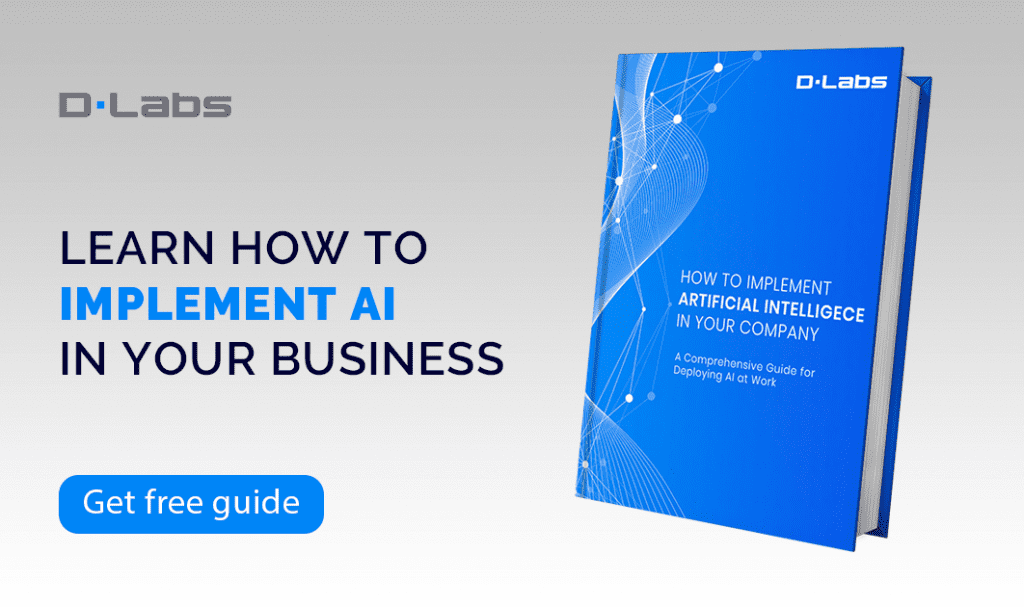The ascent of large language models, particularly GPT, has marked one of the standout tech trends this year. Companies that have incorporated GPT models into their products have consistently reported heightened competitiveness and enhanced user satisfaction.
Are you considering adding a GPT-based solution to your business framework? It would be a strategic move, and this guide provides a thorough outline of what to look at before setting sail. We touch on everything from intricate technical details to broader business ramifications.
While the journey might appear daunting, adopting a holistic perspective can considerably amplify your chances of success.
Let’s dive in.
Consider These 12 Factors Before Making Your Next Move
1. Does Your Business Even Need AI?
Before diving into the world of AI, first question if your business even needs it. From our experience, too many companies adopt AI without acknowledging more straightforward tools could do the job just fine.
For instance, tasks involving data extraction, transfer, or essential decision-making based on predefined rules might not require complex algorithms and custom AI software. In such cases, Robotic Process Automation (RPA) or traditional automation software could suffice, delivering the desired efficiency without the costs and complexities of AI.
That’s why you should approach AI with a clear-eyed evaluation. Start by identifying the problem you’re trying to solve, then explore all potential solutions (beyond the AI-driven ones). And remember: the goal is to find the most efficient, cost-effective method.
Don’t jump on the latest tech bandwagon just for the sake of it.
2. Data Privacy
In AI projects, it’s not just about having data. It’s about ensuring that this data is handled ethically and legally. Companies must be wary about data privacy, especially in sectors where sensitive data, like health or personal information, is prevalent.
Especially in regions with strict data protection laws, gaining explicit and informed consent from users is crucial. This involves creating clear and concise consent forms, managing support revocation, and ensuring data is processed only to the extent permitted.
Additional reading: Everything You Need to Know About NYC’s Automated Employment Decision Tools (AEDT) Law.
3. Company Location
The location of your company’s HQ, operations, and data storage can dictate how you approach data processing, especially in AI. And the patchwork of global data protection laws means there isn’t a one-size-fits-all solution.
Especially for companies operating internationally, understanding how data can be transferred between countries is vital. Some regions, like the EU, have strict regulations about sharing personal data outside the bloc. If you operate within or engage with entities in the European Union, the EU AI Act is a pivotal piece of legislation that shapes AI’s ethical and legal landscape.
Remember that non-compliance with data protection regulations can result in more than just financial penalties. Companies might face operational disruptions, customer trust loss, and brand reputation damage. Moreover, data protection laws are not static.
As privacy concerns grow and technology evolves, legislation will be updated. And you need to regularly review and adjust your practices in line with any changes.
4. Data Type, Quality & Availability
Data is the lifeblood of AI and machine learning, yet it varies in type, sensitivity, and processing demands. Companies also risk breaches, non-compliance, and potential reputational damage if they fail to develop a tailored approach to data handling.
That’s why it’s crucial to categorize data into various types before you process it, including personal, transactional, behavioral, or sensor-generated data. Each category might have different implications for both ethics and legality.
Specific data points like health records, financial information, or personal identifiers are considered sensitive within these categories. Recognizing these subsets ensures you apply the necessary security measures and legal safeguards.
Furthermore, the integrity of your AI project hinges on a comprehensive data quality review, which should entail:
- Availability: ensuring the requisite data is at your disposal.
- Format: determining the structure of your data and identifying any preprocessing needs.
- Readability: ascertaining the data is decipherable and corruption-free.
- Quantity: the volume of data can profoundly influence a model’s accuracy and efficiency.
5. Data Security
Beyond processing, how data is stored is essential. Secure encryption methods, both in transit and at rest, can protect data from breaches and unauthorized access.
Data minimization is also good practice. This principle stresses the importance of collecting only absolutely necessary data; by minimizing the data you handle, you reduce the potential risk and streamline processing efforts.
When it comes to sensitive data, anonymization can also help. Techniques like data masking, pseudonymization, or tokenization can convert sensitive data into a format where identifying individual data becomes impossible without a decryption key.
Additional reading: 6 Essential Tips to Enhance Your Chatbot Security in 2023
6. Costs
Implementing AI technology, including LLMs like GPT, involves significant costs that must not be overlooked during planning.
Here are examples of the costs you need to consider:
- GPT tokens: the price of GPT tokens can weigh on a budget. Each interaction with the GPT model, be it text generation or analysis, consumes a certain number of tokens, which incurs a cost. To better understand tokenization and its costs, check the Tokenizer from Open AI.
- AI integration resources: beyond the direct costs associated with the model, there are expenses related to the resources required to integrate the AI model with existing systems. These can include hardware and software.
- Staff preparation: implementing new technology requires personnel. And people require training, workshops, or even specialists and consultants to help deploy and manage the AI.
7. Measurement and Impact
A project’s success is determined by its eventual impact. In AI, where tasks can be complex and resource-intensive, having clear, quantifiable success metrics is crucial.
This is how to establish clear benchmarks for your project:
- Business alignment and KPIs: Ensure your AI project aligns with your overarching business objectives. At DLabs.AI, we always assess a client’s business using the Business Model Canvas. We’ve also developed an AI-KPI business engine, which begins with a workshop designed to identify how the GPT project will integrate with the business model to maximize value. This helps our clients determine how to enhance existing or emerging KPIs.
- Quantifying ROI: The Return on Investment (ROI) isn’t just about monetary returns. While the financial outcome is crucial, other facets like time saved, efficiency gained, or customer satisfaction should also be a factor. Defining how ROI will be calculated — whether through direct profits, cost savings, or other intangible benefits — is essential to judge a project’s success.
- Anticipated results vs. actual outcomes: Set clear expectations for the project’s outcomes. By pre-defining what success looks like, you can continuously compare expected results with actual outcomes, making real-time adjustments as necessary.
Establishing these parameters from the get-go ensures a clear direction and purpose.
8. Staff Preparedness and Training
Even the most advanced AI system can be rendered ineffective if the personnel handling it aren’t adequately trained or ready for its implementation. Before integrating GPT-based or any other AI system, here are a few points to consider:
- Skill level analysis: start by assessing the current skill levels of your team. Do they have a basic understanding of large language models? Are team members familiar with the nuances of GPT?
If your internal team lacks this expertise, a partnership with an outside AI company with a proven track record might be worth considering. Leveraging external expertise can bridge the knowledge gap and ensure successful implementation. - Continuous training: AI is an ever-evolving field, especially models like GPT. Even after the initial implementation, continuous training sessions are crucial to keep your team updated with the latest advancements and best practices.
- Resistance to change: one of the most significant challenges in implementing new technology is the natural resistance to change. Understanding and addressing any reservations your employees might have about AI is essential. Open dialogue, workshops, and hands-on sessions are the key.
9. Deciding Between a Custom Model or an External API
As businesses delve into the vast realm of AI, one pivotal decision stands out: should you custom-build your own AI model or capitalize on the capabilities of an existing API? While the second option is easier to implement, particularly under tight deadlines, crafting your own model has its advantages
See if the following sways your decision towards a custom model:
- Tailored solutions: leveraging a proprietary model means you can custom-design your AI to perfectly fit the nuances of your business rather than bending your objectives to fit the limitations of an external API.
- Competitive differentiation: owning your AI model can serve as a unique selling point, differentiating your offerings from competitors who might simply rely on generic solutions. In turn, this can resonate with customers seeking specialized solutions.
- Control and flexibility: using your own model allows you to adapt, modify, or scale the AI as you see fit without being tied to the constraints or changes made by external API providers.
- Long-term cost benefits: while initial development might be resource-intensive, having your own model might save on costs that would otherwise go towards licensing or usage fees.
- IP valuation and business growth: As businesses evolve, their IP can become valuable, especially in tech-driven markets. Having proprietary AI technology can enhance a company’s overall valuation, making it more appealing to investors, partners, or potential acquirers.
10. Evaluate Existing Solutions You Can Use
Before immersing yourself in development, be sure to explore established resources.
Existing models or APIs could provide functionalities that align with your project goals. Leveraging them could accelerate your timeline and reduce the cost and effort required to reach a prototype or finished product.
These solutions can also serve as an invaluable foundation, allowing for further customization and tweaking to cater to unique requirements. In essence, starting with an existing framework can pave the way for a more streamlined and efficient developmental trajectory.
11. Compatibility
Every organization has its unique blend of legacy tools, platforms, and customized solutions. Introducing a new element without vetting its compatibility first can lead to unforeseen disruptions.
Such issues impact daily operations and increase downtime, often requiring troubleshooting and inflating operational costs. A seamless software integration, on the other hand, promises a smoother transition for all stakeholders.
- For end-users: it translates to an intuitive experience without extensive retraining.
- For IT teams: it means fewer support tickets and more time to focus on value-added tasks.
Moreover, compatibility paves the way for more efficient data flow between systems, ensuring that business insights derived are accurate and timely. Therefore, before deploying, always conduct thorough testing.
This includes checking the technical fit and understanding how the new software will fit into existing workflows, processes, and roles. By ensuring a harmonious integration, you can sidestep potential pitfalls and capitalize on the full potential of your new software.
Eager to move forward? Craft your GPT-driven project with DLabs.AI
As you can see, launching a GPT-based project involves lots of preparation and plenty of decisions.
If need a support of AI professionals who know all about GPT, schedule a free AI consultation with us today.





